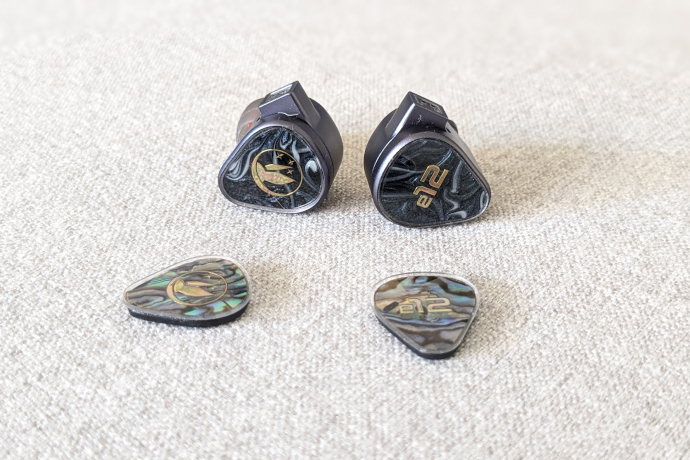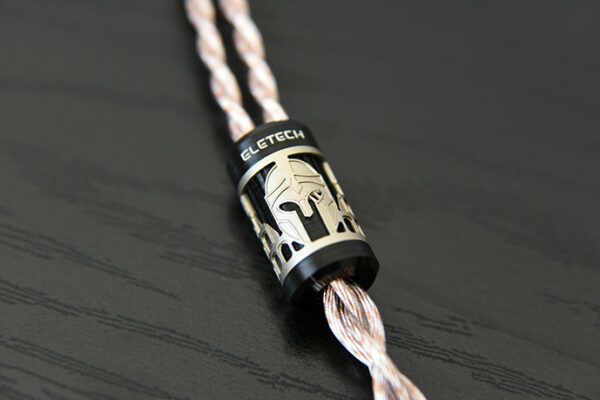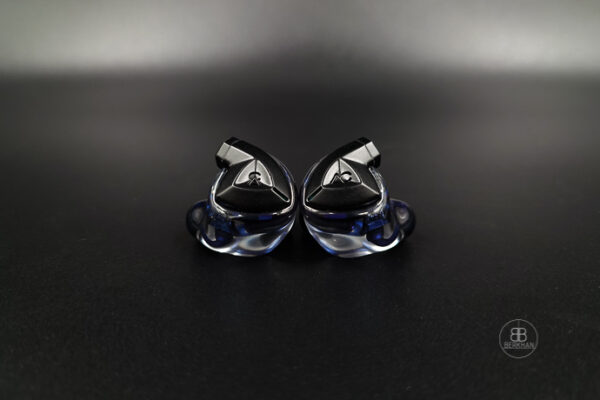The bass of the Electron 12 is fast, precise and powerful. It reaches deep into the sub-bass levels. Lows are rendered with nice texture and resolution. They have good body and weight to them, but seem a bit dense at times. This density does give them that extra control over speed though. The bass is particularly nice if you fancy electronic genres or other bass intense music. Here I find the Electron to perform especially nice. More “natural” bass notes do come across with good shape and body, but can appear a bit too snappy at times. Bass is dynamic, agile and exciting. I have found myself bopping along with the songs many times because of this.
Usually when the bass is tuned more forward like on the E12, it also gives a warm boost to the lower midrange and mids in general. And here is what makes the E12 stand out, because the mids are natural-neutral tuned with high levels of transparency and airiness. The mids are more on the dryer side with high resolution and texture. If you are looking for a glowing and rich sound, then the E12 might not bring to the table what you desire.
Instruments and vocals appear in a grand way, being tall in size but a bit lighter in body. That lighter body coupled with the airiness makes singers come across with a lot of emotion. For my taste they could use an extra dose of richness and warmth, which would make music a bit more connecting. Something that grabs the attention more.
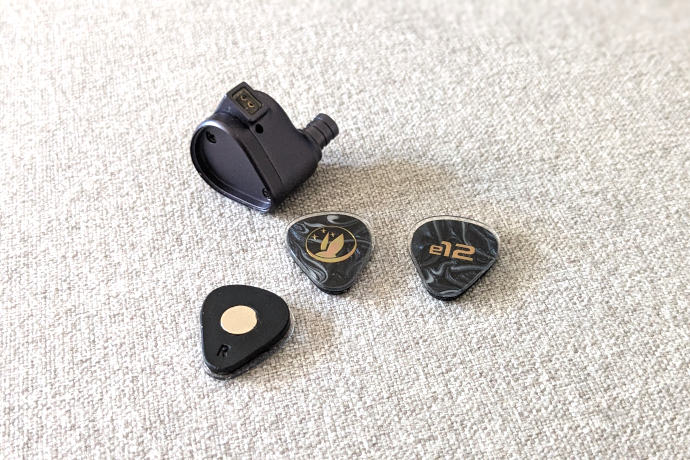
The high notes are tuned a bit more forward again, with the lower treble being fast and crisp. The extension of the Electron 12 is rolling off a bit early. Lower treble energy is on the higher side, but to my ears, it still is not at dangerous levels of producing hot sibilance. That, however, is subject to your personal treble tolerance.
Where the Electron12 performs exceptionally well is in its technicalities. It produces a wide sound stage with good depth measures and layering. I could always pin point the musicians in the room and clearly separate them from each other. The background is dark, but not pitch black. E12’s resolution is also of high quality, where you can pick out nuances in the music with ease. Sure, it is not detail monster, but for a single driver IEM this is outstanding performance.
Comparisons
Alright, now that we have taken a look at how the E12 sounds, let’s check out how it stands up against the market.
For this section I have decided to let the Electron step into the ring against other new kids on the block. Even if they are positioned in more expensive fields than the E12. Because, why not.
All IEMs were used with their stock cables and ear-tips. My source of choice was the Lotoo PAW Gold Touch, with all DSP and SRC options turned off.
vs 64 Audio U4s
The U4s has impressed me deeply in the previous year as an entry-level monitor. If you can call it that at $ 1,099.
A trait that the U4s brings to the table is replaceable apex modules, with which you can shape the sound to your preference. This gives you higher versatility for sound and isolation levels. I usually have the gold module (-12) installed in my U4s, because it gives me the most balanced signature. To bring the bass levels up to the E12’s, I need to go to -15 or even -20dB.
For my preference, and this comparison, I have picked the golden module for my four driver hybrid.
The E12 does have a more energetic and powerful low end, with a denser sound and structure than the U4s. The U4s on the other hand sounds more organic and coherent from bass to mids, where the lows flow into the lower mid-range more. This gives the overall signature more warmth in comparison to the E12. This is also one of the key differences between those two models in my opinion. The U4s goes for a fuller and warmer sound overall, while the E12 is airier and more transparent.
Where the E12 puts the U4s in its rear-view mirror is definitely in sound-stage width and sound-size in general. Music appears more holographic and bigger on the E12, while it is more focused on the U4s. Instrumental separation is also a point that goes straight to FiR’s IEM. Although the background of the U4s is darker, the E12 manages to highlight musicians better and with higher resolution as well.
The U4s does reach a touch further up top in treble, where the roll-off is later in the response. To my ears, the highs are harder edged on the E12, giving them more bite than the calmer U4s’. The U4s does have a brighter sound though, where notes in general appear heavier lit than on the E12.
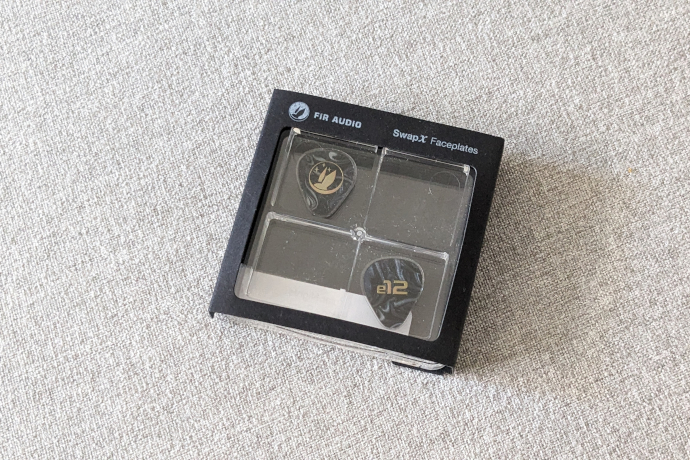
FiR Audio E12
vs Craft Ears Omnium
The Craft Ears Omnium has only recently landed at my doorstep, but it has already left an impression on me. Although these might be a bit early on, as the review process is still ongoing. However, the Omnium uses a tri-brid design, with a dynamic driver for lows, a planar magnetic driver for mids and five balanced armatures for treble. Apart from the configuration, the Omnium is also more expensive, as it comes in at € 2,499.
The Omnium has a bass presence similar to the E12, but with lower density and slightly less prominance. The Electron punches harder with more impact, but the Omnium has a more natural drive to it. Giving bass notes a more fluid presentation throughout. The upper bass also gives more coloration to the mids on the Omnium, making it sound warmer and fuller than the E12.
The Electron on the other hand creates a more transparent sound with a bigger scene and more air in the mids. The E12 constructs a stage that may be a touch wider than the Omnium’s, but the Craft Ears IEM does reach more into depth and puts everything on a darker background, giving it also the upper hand in layering and imaging.
Overall the Omnium has a richer tonality, where things are wetter than on the E12. Upper mids have a more saturated glow in them. But when it comes to treble, and especially lower treble, it is the FiR monitor that has more energetic and playful, whereas the Omnium might leave with a lower presence count.
vs 64 Audio Volür
The Volür is 64 Audio’s latest introduction to the audiophile market. It uses a ten driver setup, with a dual dynamic driver isobaric configuration for lows and eight balanced armatures for the rest of the spectrum. At $ 2,499 it is a full $ 700 more expensive than the Electron 12. Just like with the U4s, you can swap out apex modules to shape sound and isolation to your preference.
For the Volür my preferred module is the black one, dialing the isolation down to -10dB. Which is also the lowest setting available. Again, if you want more bass, you can use a different module.
The Electron has a more powerful low end, that throws a meaner punch than the Volür’s. Bass is again denser on the E12, but it reaches deeper on the Volür. In terms of speed, these two are much alike. The Volür puts out a more organic bass response, with more flesh and richness. Both have excellent values when it comes to texture and resolution down low.
With the black module installed, the Volür’s and the E12’s mids are quite similar. Although the 64 Audio IEM sounds a tad darker to me, whereas the Electron transports more air in its mids. This makes the mid-range sound somewhat grander and more emotional on the E12 than on the Volür. Singers, especially deep male vocals, sound more in reach with the Volür.
The sound-stage of the Volür is just a tiny bit more compressed than on the E12, which stretches wider. With the E12 you get more of a concert-hall experience, while the Volür creates a more intimate venue here. That is not to say, that the Volür has a small stage though, just not as big as the Electron’s.
Volür creates a darker background and lights up the instruments with better precision. While the Volür has the upper hand in that regard, it has to take second place when it comes to resolution. Here is where the E12 comes out as top dog. Contrast and dynamic range is again what the 64 Audio monitor runs away with.
The treble of both is quite similar in the lower regions, but when it comes to extension it is hard to overlook the tia driver’s push on the Volür. The more forward response of the Volür does make the sound of the 64 Audio monitor a bit more brittle to my ears. Whereas the FiR IEM might have more lower treble energy, it is not as brightly tuned as the Volür’s upper segment. That is all down to personal tolerances though.
Final Verdict
That has been an interesting ride.
The Electron 12 convinces with a powerful, dynamic and energetic low end as well as with a head-scratching stage construction. It features a highly transparent mid-range that will definitely please many audiophiles around the world. The new faceplate design and versatility is also a fun addition to the product itself, giving the customers the option to build a custom set of universal IEMs.
Over the past 18 months or so, FiR Audio has consistently grown more and more on me, with the Radon 6 being my personal GOAT monitor. The E12 is a very welcome addition to the collection, although I wish the mids were a tad warmer. Thankfully EQ’ing is a thing.
Pros:
– Durable metal shells
– Customize-able faceplate designs
– Powerful lows
– Transparent mids
Cons:
– Lacks richness
– No protective mesh-screens







